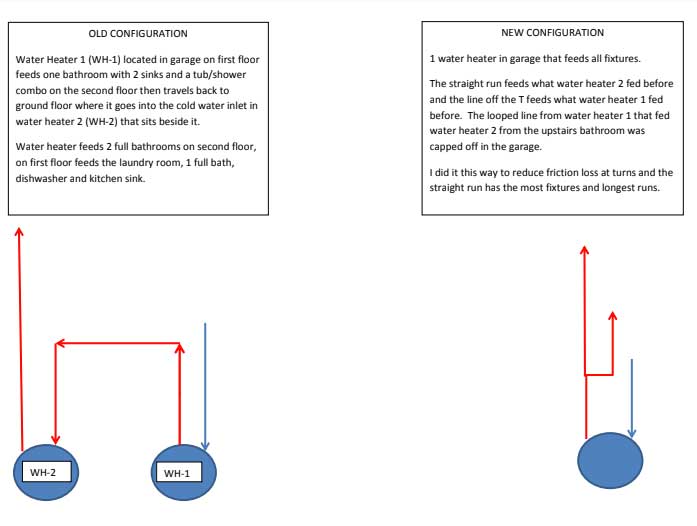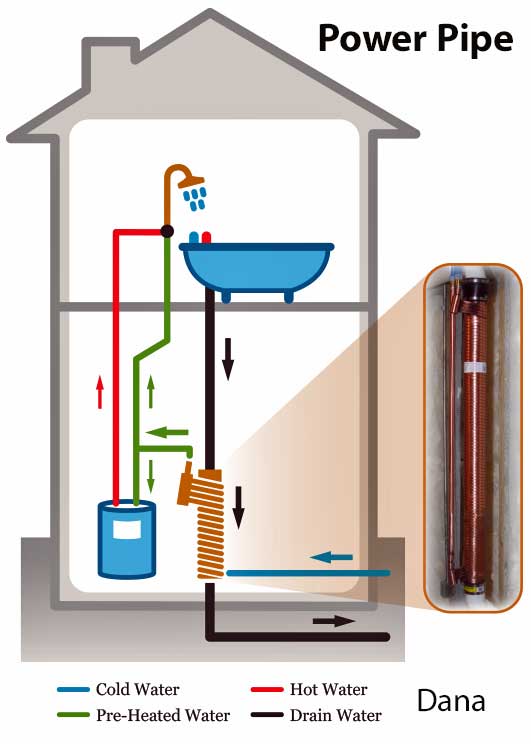ajohansson
Member
Fair warning this is long...
Been in this tract home for 1 year now. It was originally built 15 years ago. Had 2 - 40 gallon atmospheric vented hot water heaters in the garage when built. Shared same 4" vent pipe up to second floor roof. . We bought it from the original owner. At some point he replaced both of them and decided to go to a 50 gallon on one and left a 40. When the inspector went through the house he noticed one bathroom up stairs had no hot water. Went to the hot water heater and one was on with pilot lit and the other had no pilot. The one that was off fired right up and he went about his inspection. He checked on it 2 hours later and it was still lit and just happened to mention it to me that there may be an issue with it down the road and that it was manufactured in 2008 and had a 12 year warranty. He also said the first water heater inline that was out goes to the second floor bathroom and the loops back down and feeds the second water heater that feeds the rest of the fixtures in the house which includes 3 full baths, kitchen/dishwasher and laundry room.
So We move in last March. No issues with the water in the home other than the inspector didn't check the water pressure as I find it at 105 psi. A whole other issue that I already solved.
So come winter this year (in so cal but it gets into the low 30s and high 20s a couple weeks a year for overnight lows) that water heater will go out. Super random. I call us craftmaster they tell me to replace thermocoupler. I do that. Still randomly will shut off but always lights up immediately. US Craftmaster sends me a new gas control valve. I put that in and still randomly shuts off. I do some research and start checking for back draft. Well the 40 gallon one always backdrafts when the 50 and 40 are on at the same time. I talk to a friend of mine whos father is a plumber and he thinks that potentially since the 50 has a bigger burner and combusts more, that the shared 4" vent pipe cant handle all the combustion and that its happening in the winter because of the heavier denser cool air. He thinks that's why its so random and all spring and summer we were fine. He also thought it was strange how one water heater went upstairs to the bathroom and then fed the second water heater. He mentions maybe going to one 75 gallon water heater.
So since the 50 gallon heater was a 2013 and 40 was having issues I got rid of the 40. We had been taking for back to back showers with the 50 with a thermo-mixing valve so I felt confident just staying with the 50 gallon and into going to a 75. The drywall finished water heater stand was in sore shape so I demolished the box and rebuilt it with water resistant hardibacker ( i love it by the way I can stand on it and no drywall texture getting jacked up) I should say i finished it with hardibacker I did use 5/8 drywall for firecode just put the 3/8 hardibacker on it. I also made it smaller and created room for a slop sink in the garage for a future project.
So I get water heater in and I kept the plumbing the same. Hot water went up to second floor bathroom and then I just looped the pipe in the garage that fed where the second water heater was. That was a mistake as I had horrible water pressure at my shower which is at the end of the line from the original second water heater. So I changed it up so the hot water out is inline with the feed to the majority of the fixtures and it has a T to the bathroom on the second floor and I capped the return line. This improves flow dramatically in my shower. I leave my shower going and turn on the bathroom shower on second floor that is off the T and it is flowing well. I go back to my bathroom and its reduced. Not dramatically but I used to be able to run both showers simultaneous with great pressure
So how could removing a water heater that is just storage vessel that does not have a bladder in it and doesn't regulate pressure cause a reduction like this? I started to think since I moved the water heater around so much taking it down and putting it back up perhaps I dislodged a bunch of scale. I flushed it again and lots of white scale rocks come out. Could that be the issue perhaps? We have hard water and my water heater sounds like a microwave with a bag of popcorn in it so I'm hoping there isn't an issue. But I do have a cash-acme thermal mixing valve that has a screen on its inlet so that shouldn't be the case. I just put in new screens but I guess they could be clogged potentially which is something I will check but if that's not it from hydraulics point of view did the way I decide to plumb it sound correct? Would removing the second water heater cause a volume issue like this?
here is a diagram of old and new.

Any help appreciated.
AJ
Been in this tract home for 1 year now. It was originally built 15 years ago. Had 2 - 40 gallon atmospheric vented hot water heaters in the garage when built. Shared same 4" vent pipe up to second floor roof. . We bought it from the original owner. At some point he replaced both of them and decided to go to a 50 gallon on one and left a 40. When the inspector went through the house he noticed one bathroom up stairs had no hot water. Went to the hot water heater and one was on with pilot lit and the other had no pilot. The one that was off fired right up and he went about his inspection. He checked on it 2 hours later and it was still lit and just happened to mention it to me that there may be an issue with it down the road and that it was manufactured in 2008 and had a 12 year warranty. He also said the first water heater inline that was out goes to the second floor bathroom and the loops back down and feeds the second water heater that feeds the rest of the fixtures in the house which includes 3 full baths, kitchen/dishwasher and laundry room.
So We move in last March. No issues with the water in the home other than the inspector didn't check the water pressure as I find it at 105 psi. A whole other issue that I already solved.
So come winter this year (in so cal but it gets into the low 30s and high 20s a couple weeks a year for overnight lows) that water heater will go out. Super random. I call us craftmaster they tell me to replace thermocoupler. I do that. Still randomly will shut off but always lights up immediately. US Craftmaster sends me a new gas control valve. I put that in and still randomly shuts off. I do some research and start checking for back draft. Well the 40 gallon one always backdrafts when the 50 and 40 are on at the same time. I talk to a friend of mine whos father is a plumber and he thinks that potentially since the 50 has a bigger burner and combusts more, that the shared 4" vent pipe cant handle all the combustion and that its happening in the winter because of the heavier denser cool air. He thinks that's why its so random and all spring and summer we were fine. He also thought it was strange how one water heater went upstairs to the bathroom and then fed the second water heater. He mentions maybe going to one 75 gallon water heater.
So since the 50 gallon heater was a 2013 and 40 was having issues I got rid of the 40. We had been taking for back to back showers with the 50 with a thermo-mixing valve so I felt confident just staying with the 50 gallon and into going to a 75. The drywall finished water heater stand was in sore shape so I demolished the box and rebuilt it with water resistant hardibacker ( i love it by the way I can stand on it and no drywall texture getting jacked up) I should say i finished it with hardibacker I did use 5/8 drywall for firecode just put the 3/8 hardibacker on it. I also made it smaller and created room for a slop sink in the garage for a future project.
So I get water heater in and I kept the plumbing the same. Hot water went up to second floor bathroom and then I just looped the pipe in the garage that fed where the second water heater was. That was a mistake as I had horrible water pressure at my shower which is at the end of the line from the original second water heater. So I changed it up so the hot water out is inline with the feed to the majority of the fixtures and it has a T to the bathroom on the second floor and I capped the return line. This improves flow dramatically in my shower. I leave my shower going and turn on the bathroom shower on second floor that is off the T and it is flowing well. I go back to my bathroom and its reduced. Not dramatically but I used to be able to run both showers simultaneous with great pressure
So how could removing a water heater that is just storage vessel that does not have a bladder in it and doesn't regulate pressure cause a reduction like this? I started to think since I moved the water heater around so much taking it down and putting it back up perhaps I dislodged a bunch of scale. I flushed it again and lots of white scale rocks come out. Could that be the issue perhaps? We have hard water and my water heater sounds like a microwave with a bag of popcorn in it so I'm hoping there isn't an issue. But I do have a cash-acme thermal mixing valve that has a screen on its inlet so that shouldn't be the case. I just put in new screens but I guess they could be clogged potentially which is something I will check but if that's not it from hydraulics point of view did the way I decide to plumb it sound correct? Would removing the second water heater cause a volume issue like this?
here is a diagram of old and new.

Any help appreciated.
AJ
Last edited by a moderator:

